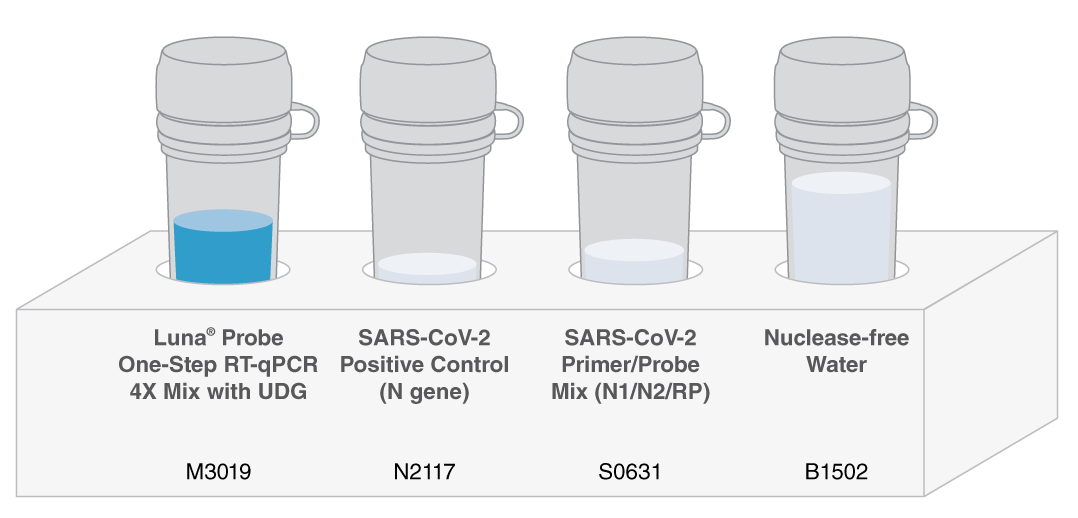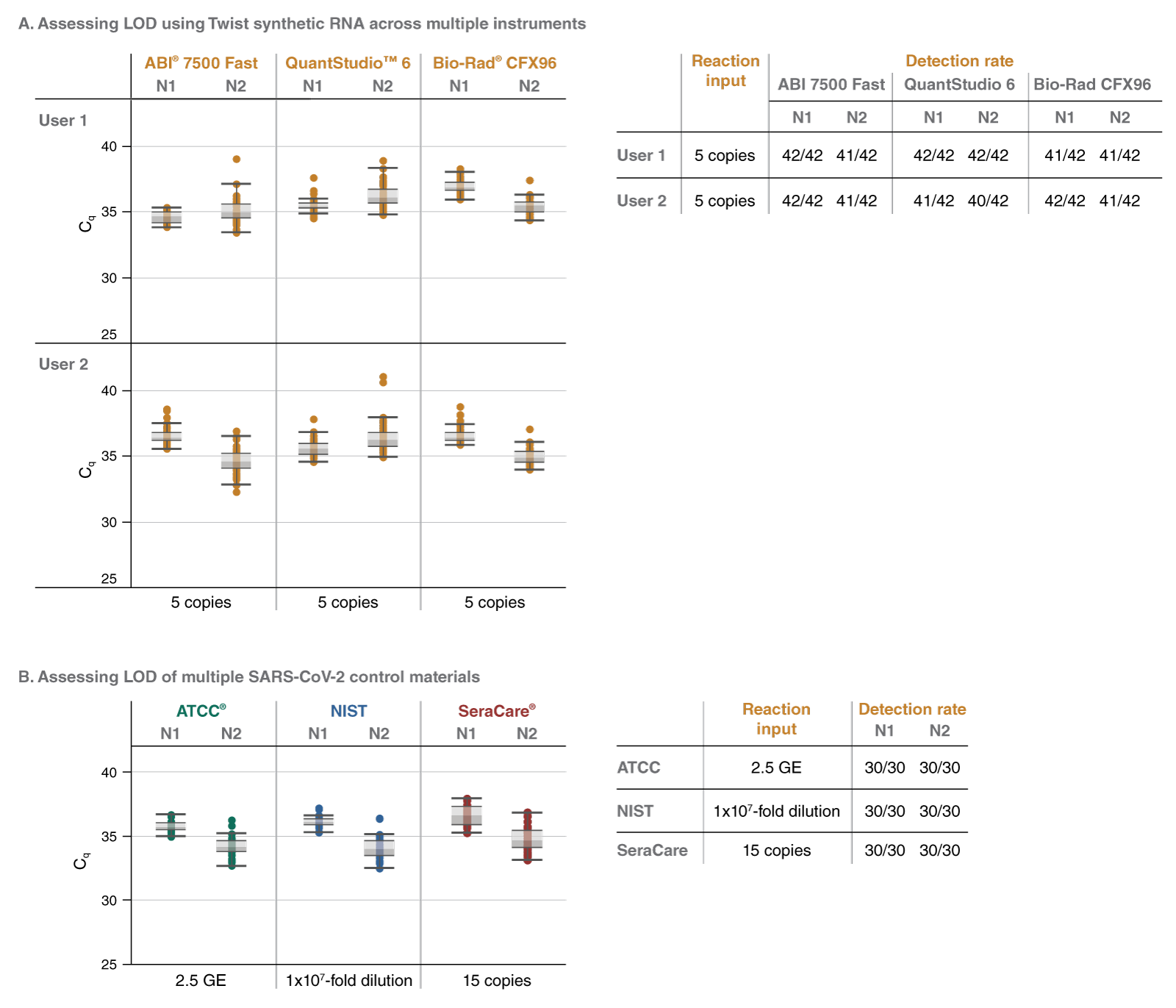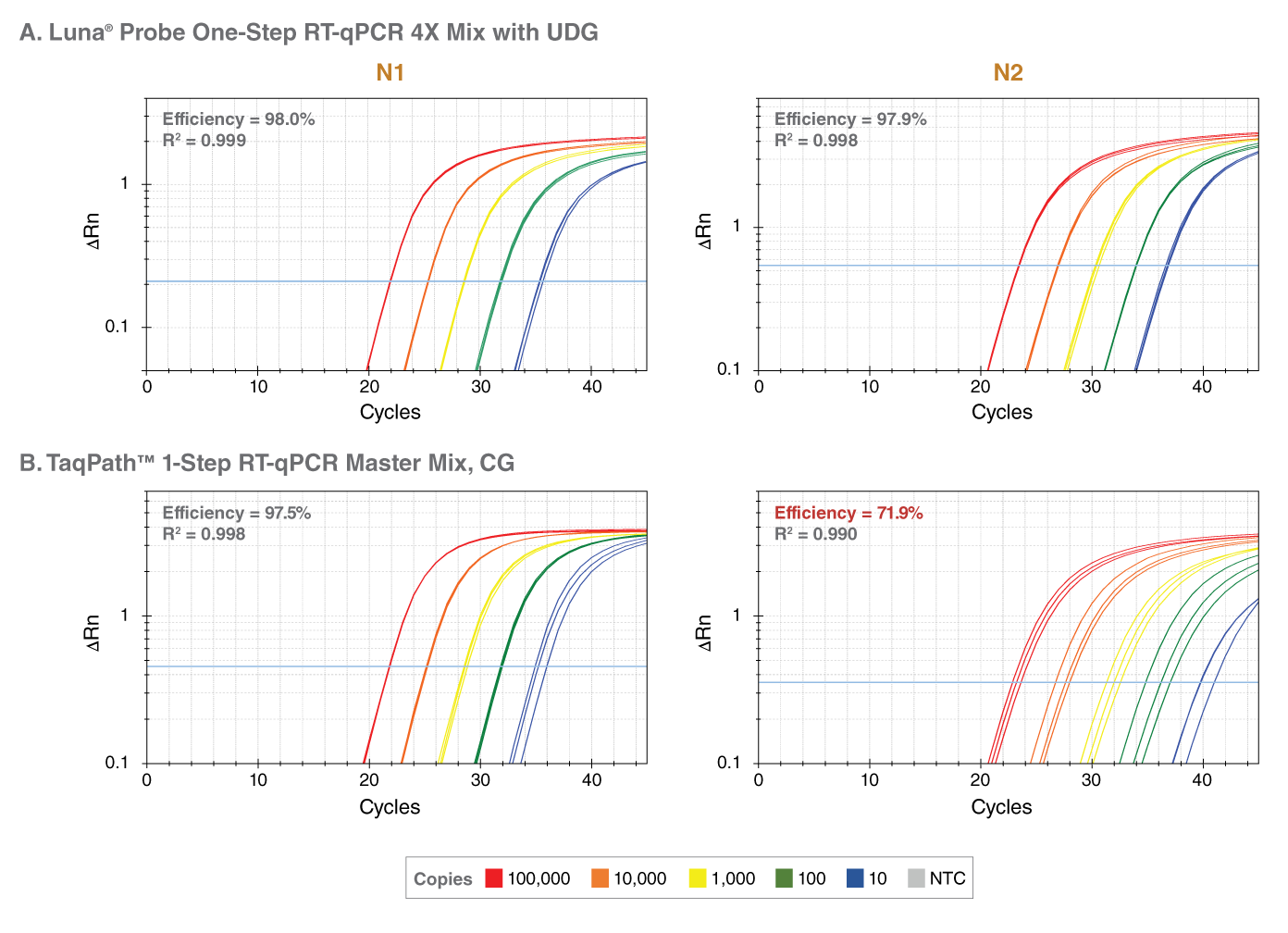Luna® SARS-CoV-2 RT-qPCR Multiplex Assay Kit
Product information| Code | Name | Size | Quantity | Price | |
|---|---|---|---|---|---|
E3019S |
Luna® SARS-CoV-2 RT-qPCR Multiplex Assay Kit |
96 rxns | - | Unavailable in your region |
Luna® SARS-CoV-2 RT-qPCR Multiplex Assay Kit
The Large size of this product (NEB #E3019L) was discontinued on December 15, 2024. The Small pack size will remain available. For Research Use Only. Not for use in diagnostic procedures.
Catalog #E3019
Product Introduction
The Luna® SARS-CoV-2 RT-qPCR Multiplex Assay Kit is a real-time RT-PCR assay for the qualitative detection of SARS-CoV-2 nucleic acid.
- What is the impact of different SARS-CoV-2 variants on this kit, including Omicron? See the updated FAQ and view the Primer Monitor (more info here) for up-to-date information on variants mapped against common primer sets.
- Multiplex detection of 2019-nCoV_N1 and 2019-nCoV_N2 targets and human RNase P gene enables high throughput workflows
- Reduce background amplification from genomic DNA by use of a modified RNase P Internal Control reverse primer to target an exon-exon boundary
- Increase sensitivity with 4X RT-qPCR mix allowing for more sample input
- Luna WarmStart® RT paired with Hot Start Taq increases reaction specificity and robustness, enabling room temperature setup
- Reduce risk of carryover contamination with thermolabile UDG and dUTP included in the master mix
- Supports sample pooling with minimal loss in sensitivity
- Learn how NEB is supporting COVID-19 research with a variety of RT-qPCR virus detection options

Using the Luna SARS-CoV-2 RT-qPCR Multiplex Assay Kit, up to 94 different samples can be assessed in a single 96-well plate. Anticipated results for each sample type are shown (in each fluorophore channel).
- Product Information
- Protocols, Manuals & Usage
- Tools & Resources
- FAQs & Troubleshooting
- Citations & Technical Literature
- Quality, Safety & Legal
- Other Products You May Be Interested In
Product Information
Description
The Luna SARS-CoV-2 RT-qPCR Multiplex Assay Kit is optimized for real-time qualitative detection of SARS-CoV-2 nucleic acid using hydrolysis probes. In a single tube, RNA is first converted to cDNA by a reverse transcriptase, then a DNA-dependent DNA polymerase amplifies the cDNA, enabling quantitation via real-time or quantitative PCR (qPCR). Probe-based qPCR/RT-qPCR monitors an increase in fluorescence upon 5′→3′ exonuclease cleavage of a quenched, target-specific probe to measure DNA amplification at each PCR cycle. At a point where the fluorescence signal is confidently detected over the background fluorescence, a quantification cycle or Cq value can be determined. Cq values can be used to evaluate relative target abundance between two or more samples.

B. The RNase P internal control includes a Cy5 labeled probe and a re-designed reverse primer. This primer spans an exon-exon junction to avoid amplification of human genomic DNA which contains a 2.4 kb intron.
The SARS-CoV-2 Primer/Probe Mix contains primers and probes specific to two regions of the SARS-CoV-2 virus N gene [based on sequences provided by the Centers for Disease Control and Prevention (CDC)]. The probes have been modified to contain different fluorophores (N1: HEX; N2: FAM) to enable simultaneous observation on two different channels of a real-time instrument. To ensure the integrity of the input material and absence of inhibition, an internal control (IC) primer and probe set, designed to amplify the human RNase P gene, is also included in the primer mix. The reverse primer of this target has been modified from the CDC design to target an exon/exon boundary to reduce background amplification from possible contaminating genomic DNA. Amplification of the IC is observed in the Cy5 channel. A positive control (PC) template (SARS-CoV-2 N gene cloned into a plasmid) is also provided.
The Luna Probe One-Step RT-qPCR 4X Mix with UDG (NEB #M3019) included in the kit enables higher amounts of input material and supports sample pooling strategies, with minimal loss of sensitivity or specificity. It contains all necessary components for one-step RT-qPCR and is formulated with a unique passive reference dye that is compatible across a variety of instrument platforms, including those that require a high or low ROX reference signal. The reaction mix also features thermolabile UDG and dUTP for carryover prevention and a non-fluorescent visible tracking dye for monitoring reaction setup. This visible dye does not overlap spectrally with fluorophores commonly used in qPCR and does not interfere with real-time detection.
TaqPath™1-Step RT-qPCR Master Mix, CG




The Luna Probe One-Step RT-qPCR 4X Mix with UDG features Hot Start Taq DNA Polymerase combined with a novel WarmStart-activated reverse transcriptase, allowing dual control of enzyme activity via reversible, aptamer-based inhibition. This temperature-dependent activation helps to prevent undesirable non-specific priming and extension prior to thermocycling, providing added security for setting up reactions at room temperature. The engineered WarmStart Luna Reverse Transcriptase also possesses higher thermostability than many other RTs, allowing an optimal reaction temperature of 55°C.

- This product is related to the following categories:
- Luna® qPCR & RT-qPCR,
- PCR, qPCR & Amplification Technologies,
- This product can be used in the following applications:
- qPCR & RT-qPCR
Kit Components
Kit Components
The following reagents are supplied with this product:
| NEB # | Component Name | Component # | Stored at (°C) | Amount | Concentration | |||||||||||||||||||||||||||||||
|---|---|---|---|---|---|---|---|---|---|---|---|---|---|---|---|---|---|---|---|---|---|---|---|---|---|---|---|---|---|---|---|---|---|---|---|---|
| ||||||||||||||||||||||||||||||||||||
Properties & Usage
Features
- Support for high throughput workflows, including 384-well plate test formats (compatible with low reaction volumes)
- UDG and dUTP included in master mix for carryover prevention, reduced risk of contamination
- Optimized primer/probe mix offers enhanced detection and sensitivity
- Dual WarmStart/Hot Start enzyme formulation enables room temperature setup and stability up to 24 hours
Related Products
Companion Products
Protocols, Manuals & Usage
Protocols
Manuals
The Product Manual includes details for how to use the product, as well as details of its formulation and quality controls.
Application Notes
- High-throughput qPCR and RT-qPCR Workflows Enabled by Beckman Coulter Echo Acoustic Liquid Handling and NEB Luna Reagents
- The Luna 4X RT-qPCR Mix and Luna SARS-CoV-2 RT-qPCR Multiplex Assay Kit enable high throughput, automated detection workflows
- Primer Monitor: an online tool to track SARS-CoV-2 variants that may impact primers used in diagnostic assays
- Facilitating Purification and Detection of Viral Nucleic Acids from Milk
Tools & Resources
Web Tools
FAQs & Troubleshooting
FAQs
- Do different SARS-CoV-2 variants impact the effectiveness of the Luna SARS-CoV-2 RT-qPCR Multiplex Assay Kit?
- What components are included in the Luna SARS-CoV-2 RT-qPCR Multiplex Assay Kit?
- How many test samples can be run on a 96-well plate?
- Does the Luna SARS-CoV-2 RT-qPCR Multiplex Assay Kit enable carryover prevention/contamination reduction?
- Can I set up the SARS-CoV-2 assay at room temperature?
- How much sample can be added to the reaction as input for the SARS-CoV-2 assay?
- What targets do the SARS-CoV-2 Primer/Probe mix detect? How were these primers chosen?
- Is the sequence of the RNase P primer/probe set the same as the CDC?
- What is the SARS-CoV-2 Positive Control included in the kit?
- How are results interpreted in the Luna SARS-CoV-2 RT-qPCR Multiplex Assay Kit?
- How stable is the Luna SARS-CoV-2 RT-qPCR Multiplex Assay Kit primer mix?
- What types of samples/materials are compatible with the Luna SARS-CoV-2 RT-qPCR Multiplex Assay Kit?
- What instruments are compatible with the Luna SARS-CoV-2 RT-qPCR Multiplex Assay Kit?
- What are the sequences for the primers and probes included in the kit?
- Can I prepare a plate in advance?
Citations & Technical Literature
Citations
Quality, Safety & Legal
Quality Assurance Statement
Quality Control tests are performed on each new lot of NEB product to meet the specifications designated for it. Specifications and individual lot data from the tests that are performed for this particular product can be found and downloaded on the Product Specification Sheet, Certificate of Analysis, data card or product manual. Further information regarding NEB product quality can be found here.Specifications
The Specification sheet is a document that includes the storage temperature, shelf life and the specifications designated for the product. The following file naming structure is used to name these document files: [Product Number]_[Size]_[Version]Certificate Of Analysis
The Certificate of Analysis (COA) is a signed document that includes the storage temperature, expiration date and quality controls for an individual lot. The following file naming structure is used to name these document files: [Product Number]_[Size]_[Version]_[Lot Number]- E3019L_v1_10092225
- E3019S_v1_10092230
- E3019L_v1_10104995
- E3019S_v1_10104994
- E3019S_v1_10108769
- E3019L_v1_10108770
- E3019L_v1_10111841
- E3019L_v1_10121084
- E3019S_v1_10123078
- E3019L_v1_10125551
- E3019L_v1_10130846
- E3019L_v1_10132125
- E3019L_v1_10134716
- E3019L_v1_10134875
- E3019L_v1_10135262
- E3019S_v1_10133078
- E3019L_v1_10137486
- E3019L_v1_10139525
- E3019L_v1_10139570
- E3019L_v1_10140882
- E3019L_v1_10141276
- E3019L_v1_10141412
- E3019L_v1_10141865
- E3019S_v1_10143642
- E3019L_v1_10146113
- E3019S_v1_10149316
- E3019L_v1_10164055
- E3019S_v1_10164056
- E3019S_v1_10166257
- E3019L_v2_10166258
- E3019S_v2_10179736
- E3019S_v2_10183729
- E3019L_v2_10184734
- E3019S_v2_10208161
- E3019L_v2_10225979
- E3019S_v2_10231235
- E3019S_v2_10272661
- E3019S_v2_10292860
- E3019S_v2_10294424
Safety DataSheets
The following is a list of Safety Data Sheet (SDS) that apply to this product to help you use it safely.Luna® Probe One-Step RT-qPCR 4X Mix with UDG
SARS-CoV-2 Positive Control (N gene)
Nuclease-free Water
Legal and Disclaimers
Products and content are covered by one or more patents, trademarks and/or copyrights owned or controlled by New England Biolabs, Inc (NEB). The use of trademark symbols does not necessarily indicate that the name is trademarked in the country where it is being read; it indicates where the content was originally developed. The use of this product may require the buyer to obtain additional third-party intellectual property rights for certain applications. For more information, please email busdev@neb.com.This product is intended for research purposes only. This product is not intended to be used for therapeutic or diagnostic purposes in humans or animals.
New England Biolabs (NEB) is committed to practicing ethical science – we believe it is our job as researchers to ask the important questions that when answered will help preserve our quality of life and the world that we live in. However, this research should always be done in safe and ethical manner. Learn more.
Licenses
Notice to Purchaser: Nucleic acid-based aptamers for use with thermophilic DNA polymerases are licensed exclusively by New England Biolabs, Inc. from SomaLogic, Inc. (See Patent Nos. 7,947,447; 8,404,830; 8,975,388 and their foreign equivalents). New England Biolabs, Inc. gives the Buyer/User a non-exclusive license to use this product for Research Purposes Only. Commercial use of this product requires a license from New England Biolabs, Inc. Please contact busdev@neb.com for more information.Other Products You May Be Interested In
The supporting documents available for this product can be downloaded below.



